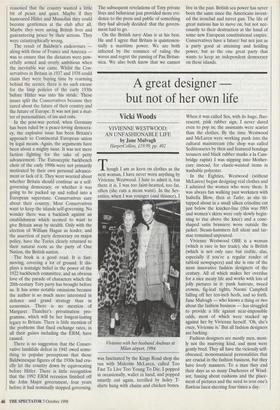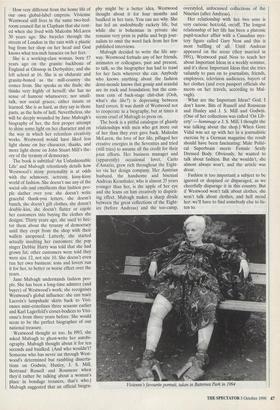A great designer but not of her own life
Vicki Woods
VIVIENNE WESTWOOD: AN UNFASHIONABLE LIFE by Jane Mulvagh HarperCollins, £19.99, pp. 402 Though I am as keen on clothes as the next woman, I have never worn anything by Vivienne Westwood. I hate to admit it, but there it is. I was too faint-hearted, too fat, often (she cuts a mean waist). In the Sev- enties, when I was younger (and thinner), I Vivienne with her husband Andreas at Milan airport, 1994.
was fascinated by the Kings Road shop she ran with Malcolm McLaren, called Too Fast To Live Too Young To Die. I popped in occasionally, wallet in hand, and popped smartly out again, terrified by holey T- shirts hung with chains and chicken bones. When it was called Sex, with its huge, fluo- rescent, pink rubber sign, I never dared even to pop in; the assistants were scarier than the clothes. By the time Westwood and McLaren were working punk into the cultural mainstream (the shop was called Seditionaries by then and featured bondage trousers and black rubber masks a la Cam- bridge rapist) I was nipping into Mother- care instead, for elastic-waisted items in washable polyester.
In the Eighties, Westwood (without McLaren) began designing real clothes and I admired the women who wore them. It was always fun walking past workmen with Isabella Blow, then at Taller, as she tit- tupped about in a small silken crinoline cut just below the knicker-line (this was 1985 and women's skirts were only slowly begin- ning to rise above the knee) and a cone- shaped satin brassiere worn outside the jacket. Steam-hammers fell silent and tar- mac remained unpoured.
Vivienne Westwood OBE is a woman (which is rare in her trade), she is British (which is not only rare but risible, alas, especially if you're a regular reader of tabloid newspapers) and she is one of the most innovative fashion designers of the century. All of which makes her overdue for a nice meaty life and works with lots of jolly pictures in it: punk haircuts, tweed crowns, fig-leaf tights, Naomi Campbell falling off her ten-inch heels, and so forth. Jane Mulvagh — who knows a thing or two about the fashion business — has struggled to provide a life against near-impossible odds, most of which were stacked up against her by Vivienne herself. 'Oh, she's crazy, Vivienne is.' But all fashion designers are barking.
Fashion designers are mostly men, most- ly not the marrying kind, and most were gently bred. They all have the viciously self- obsessed, monomaniacal personalities that are crucial in the fashion business, but they have lovely manners. To a man they end their days as so many Duchesses of Wind- sor, fussing about cushions and the place- ment of pictures and the need to iron one's flawless linen sheeting four times a day. How very different from the home life of our own global-label empress. Vivienne Westwood still lives in the same two-bed- room council flat in Clapham that she rent- ed when she lived with Malcolm McLaren 30 years ago. She bicycles through the streets of London in the rain with a plastic bag from her shop on her head and God knows what ten-inch lunacies on her feet.
She is a working-class woman, born 57 years ago on the granite backbone of England at Glossop in Derbyshire, and she left school at 16. She is as obdurate and granite-boned as the mill-country she comes from. She speaks as she finds; she thinks very highly of herself; she has no sense of humour whatsoever, nor small- talk, nor social graces, either innate or learned. She is as hard, as they say in those parts, as the hobs of hell. Nevertheless, she will be deeply wounded by Jane Mulvagh's biography of her, the first proper attempt to shine some light on her character and on the way in which her relentless creativity works. Westwood would have liked less light shone on her character, thanks, and more light shone on John Stuart Mill's the- ory of the tyranny of democracy.
The book is subtitled 'An Unfashionable Life' and Mulvagh relentlessly details how Westwood's stony personality is at odds with the schmoozy, actressy, kissy-kissy world of fashion. She doesn't use any of the social oils and emollients that fashion peo- ple slather over you: she doesn't write graceful thank-you letters, she doesn't bunch, she doesn't gift clothes, she doesn't double-kiss, she doesn't flatter or cajole her customers into buying the clothes she designs. Thirty years ago, she used to hec- tor them about the tyranny of democracy until they crept from the shop with their wallets unopened. Latterly, she started actually insulting her customers: the pop singer Debbie Harry was told that she had grown fat; other customers were told they were size 12, not size 10. She doesn't even run her own business: sons and lovers run it for her, to better or worse effect over the years.
Jane Mulvagh understands fashion peo- ple. She has been a long-time admirer (and buyer) of Westwood's work; she recognises Westwood's global influence: she can trace Lacroix's lampshade skirts back to Vivi- ennes mini-crinolines three seasons earlier and Karl Lagerfeld's corset-bodices to Vivi- enne's from three years before. She would seem to be the perfect biographer of our national treasure.
Westwood thought so too. In 1993, she asked Mulvagh to ghost-write her autobi- ography. Mulvagh thought about it for ten seconds and baulked. (And who wouldn't? Someone who has never sat through West- wood's determined but rambling disserta- tions on Godwin, Huxley, J. S. Mill, Bertrand Russell and Rousseau when they'd rather be talking about a woman's place in bondage trousers, that's who.) Mulvagh suggested that an official biogra- phy might be a better idea. Westwood thought about it for four months and baulked in her turn. You can see why. She has led an undoubtedly rackety life, but while she is bohemian in private she remains very prim in public and begs jour- nalists to omit the word fuck from her few published interviews.
Mulvagh decided to write the life any- way. Westwood forbade any of her friends, intimates or colleagues, past and present, to talk, so the biographer has had to trawl for her facts wherever she can. Anybody who knows anything about the fashion demi-monde knows that gossip and scandal are its rock and foundation; but the com- mon coin of back-stage chit-chat (Ooh, what's she like?) is depressing between hard covers. It was dumb of Westwood not to cooperate in a biography, but at times it seems cruel of Mulvagh to press on.
The book is a pitiful catalogue of ghastly relationships with men who got more out of her than they ever gave back. Malcolm McLaren, the love of her life, pillaged her creative energies in the Seventies and tried (still tries) to assume all the credit for their joint efforts. Her business manager and (apparently) occasional lover, Carlo d'Amario, grew rich throughout the Eight- ies via her design company. Her Austrian husband, the handsome and bisexual Andreas Kronthaler, who is almost 25 years younger than her, is the apple of her eye and she leans on him creatively to dispirit- ing effect. Mulvagh makes a sharp divide between the great collections of the Eight- ies (before Andreas) and the too-camp, overstyled, unfocussed collections of the Nineties (after Andreas).
Her relationship with her two sons is very curious: hot/cold, on/off. The longest relationship of her life has been a platonic pupil-teacher affair with a Canadian mys- tery figure called Gary Ness and this is most baffling . of all. Until Andreas appeared on the scene (they married in 1991), Westwood paid Ness to teach her about Important Ideas in a weekly seminar, and it's these Important Ideas that she tries valiantly to pass on to journalists, friends, employees, television audiences, buyers of her clothes (and even passport officials she meets on her travels, according to Mul- vagh).
What are the Important. Ideas? God, I don't know. Bits of Russell and Rousseau and Huxley and J. S. Mill and Godwin. (One of her collections was called 'On Lib- erty' — hommage a J. S. Mill. I thought she was talking about the shop.) When Gore Vidal was set up with her in a journalistic exercise by a German magazine the result should have been fascinating: Male Politi- cal Superbrain meets Female Sexily Dressed Body. Obviously, he wanted to talk about fashion. But she wouldn't, she almost always won't, and the article was drear.
Fashion is too important a subject to be ignored or despised or disparaged, as we cheerfully disparage it in this country. But if Westwood won't talk about clothes, she won't talk about clothes, and hell mend her: we'll have to find somebody else to lis- ten to.
Vivienne's favourite portrait, taken in Battersea Park in 1994











































































 Previous page
Previous page